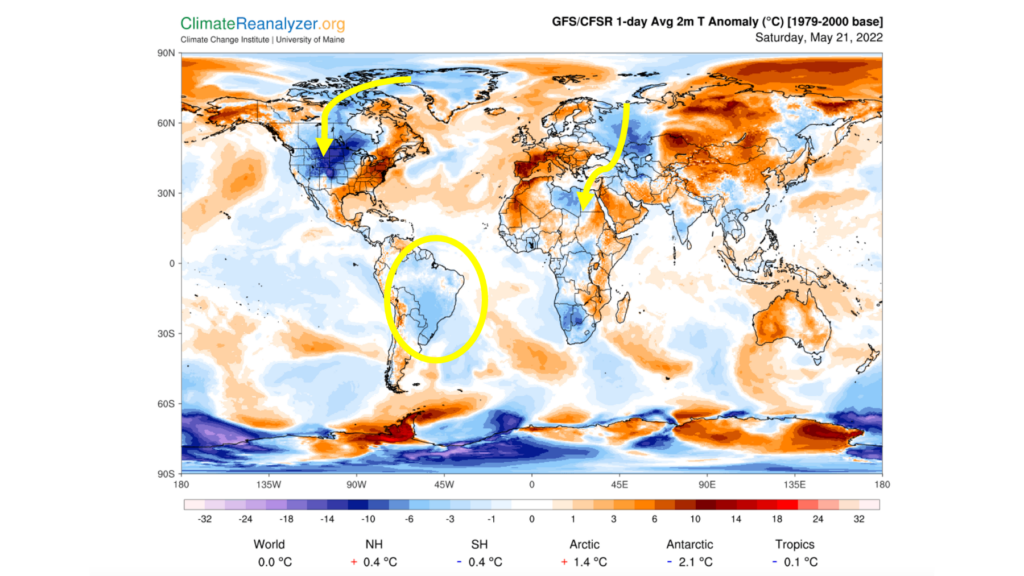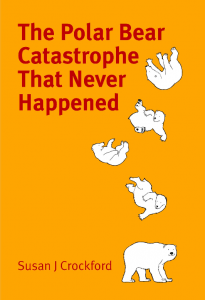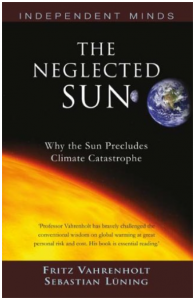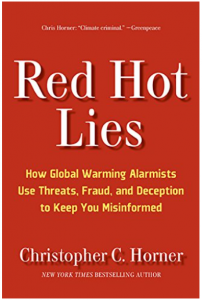Currently much is being reported on extreme heat reaching from North Africa to Europe. In some places in Morocco and Spain, new temperature records for May have been set.
However, it’s worth taking a look at the whole world, because in addition to regions that are clearly too warm, there are also the exact opposite. They’re marked with yellow on this overview from Climatereanalyzer.

Image: Screenshot Climatereanalyer.org
For example, the U.S. state of Colorado recorded snow in May, as reported by the Denver Post.
Brazil is also experiencing unusual cold. Mercopress reports record cold for the capital Brasilia, which is located far inland. The paper quotes meteorologist Estael Sias as explaining the cold snap as a result of climate change.
An unprecedented cold wave in Brazil for the month of May has been labeled a threat both to the country’s thousands of homeless people and also to crops, it was reported Thursday.
A 1.4°C mark in Brasilia Thursday became the coldest temperature in the city’s history since it was founded in 1960, with over a month to go before the official beginning of Winter in the southern hemisphere (June 21).
Sao Paulo also recorded a most unusual temperature of 6.6°C Wednesday, the second-lowest for the month of May since 1990, when it hit -4°C.
The abrupt drop in temperature is due to Cyclone Yakecan, of “anomalous trajectory”, which dragged an air current from Antarctica and “spread it over the interior of South America,” meteorologist Estael Sias explained. Sias also said these “severe and most anomalous” climatic events were “a consequence of climate change.”
Overall, however, the anomaly is 0 degrees worldwide, as can be seen from the map.
Climatreanalyzer also calculates with a reference value from 1979-2000, but at that time it was colder on Earth. Compared to the current reference value it could even mean a cooling. Important: This is a purely cut-off date consideration!





The chart says it represents one day, Saturday May 21, 2022.
Who cares about one day?
I recently read that California had 100% (99.9%) renewable energy powered electricity … for one hour of one day om Saturday April, 30, 2022.
Who cares about one hour
Strong frontal thunderstorms in France.
La Niña works. Tomorrow the front will reach western Germany. There may be a repeat of last year’s situation with precipitation over the Rhine.
https://i.ibb.co/ngQLS80/archive-2-image.png
May 27 strong cooling in northern Europe. Snow may fall in the mountains of Scotland.
If you accept that CO2, H2O, The Urban Heat Island Effect and Changing Albedo are the major sources of temperature change (assuming a constant sun) then the problem becomes very easy. Identify sites that are shielded from the effects of H2O, Changing ALbedo and the UHI effect, and you isolate the impact of CO2 on temperatures. Those sites are basically cold and dry deserts. When you isolate those locations what do you get? No warming over the past 150 years. Here is the proof.
https://imgur.com/a/IrE63Xo
Places that are too warm! Places that are too cold! It’s Climate Change, it’s our fault (mostly yours) and we’re doomed!
[…] GFS Analysis Shows Zero Warming: For Every Hot-Spot On The Planet, There’s Also Been A Cold-Spot […]
A very active low from France is reaching western Germany.
https://pl.sat24.com/pl/de/infraPolair
The last few days have seen an increase in the strength of the solar wind (a large decrease in galactic radiation). This will strengthen the jet stream over the Atlantic and Pacific and strengthen La Niña.
https://i.ibb.co/0YYtWK6/onlinequery.png
Let’s look at the surface temperature of the eastern Pacific. You can see the strong air circulation typical of La Niña.
https://climatereanalyzer.org/wx_frames/gfs/ds/gfs_nh-sat4_sstanom_1-day.png
The western Pacific has accumulated little heat, so La Niña will continue and may strengthen in November when the Humboldt Current is fed by cold water from melting ice around Antarctica.
http://www.bom.gov.au/archive/oceanography/ocean_anals/IDYOC007/IDYOC007.202205.gif
Let’s look at the surface temperature of the eastern Pacific. You can see the strong air circulation typical of La Niña.
https://climatereanalyzer.org/wx_frames/gfs/ds/gfs_nh-sat4_sstanom_1-day.png
The western Pacific has accumulated little heat, so La Niña will continue and may strengthen in November when the Humboldt Current is fed by cold water from melting ice around Antarctica.
http://www.bom.gov.au/archive/oceanography/ocean_anals/IDYOC007/IDYOC007.202205.gif
CO2 blankets the globe uniformly, and the quantum physics of the CO2 molecule are not changed by location. How can CO2 cause both warming and cooling? That is absurd, and a completely untestable hypothesis. Real science needs a falsifiable hypothesis, climate science doesn’t have one.
Nothing us falsifiable with “climate change”
The climate crisis is always coming in the future,
so you always have to wait to prove the prediction was wrong.
The imagined climate crisis has been coming in 10 to 20 years for 65 years, and will always be coming in 10 to 20 years, I suppose.
And each year the prediction will start with ‘it’s going to be worse than we thought last year’ Some people just love scary fairy tales.
There are many causes of climate change besides CO2. Some of which we may not even know yet. And then there are always random variations of a complex system. This is my list:
The following variables are known to influence Earth’s climate:
1) Earth’s orbital and orientation variations
2) Changes in ocean circulation,
ENSO and others
3) Solar Irradiance and activity
4) Natural volcanic and man made pollution aerosol emissions
5) Greenhouse gas emissions
6) Land use changes
(cities growing, crop irrigation, etc.)
7) Changes in clouds and water vapor
8) Random variations of a complex system
9) Unknown causes of climate change
The variables above are not all independent.
Both April and May have been cooler than historical averages in much of the USA’s Washington State. The top 2 charts at the link show observed daily readings (black bars) in the colder (blue) with a few near record readings.
Note that the scale is Fahrenheit and changes with each month.
https://www.wrh.noaa.gov/climate/temp_graphs.php?wfo=pdt&p=temperature&year=2022&stn=KYKM
Last June this region had record high temperatures.
Click on the “2021 Graphs” — a gray rectangle — to see this.
[…] From the NoTricksZone […]
[…] From the NoTricksZone […]
[…] From the NoTricksZone […]
[…] From NoTricksZone […]
[…] From the NoTricksZone […]
[…] Fonte: No Tricks Zone […]
[…] Full story here. […]
[…] Full story here. […]
[…] Full story here. […]
[…] GFS Analysis Shows Zero Warming: For Every Hot-Spot On The Planet, There’s Also Been A Cold-Sp… […]